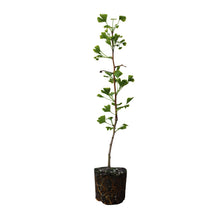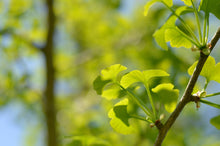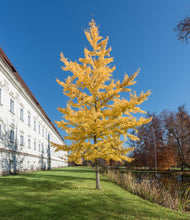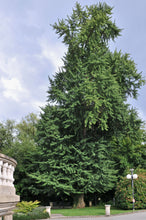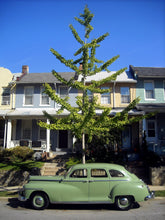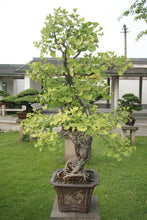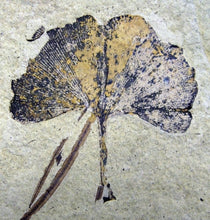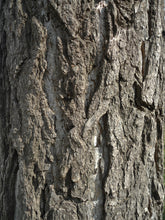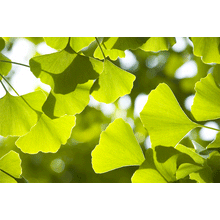
Ginkgo biloba
-
Grow your own Ginkgo biloba, a living link to the prehistoric past and a truly beautiful tree!
- 100% guaranteed
- Seed-grown on California's Redwood Coast
- Transplanting and care instructions included
 |
Moisture Medium |
 |
Cold Hardiness -25°F |
 |
Light Full Sun / Partial Shade |
 |
Size 60 – 100' tall / 30 – 50' spread |
 |
Lifespan 1,500 yrs |
 |
Growth Rate Medium |
 |
Drought Tolerance Medium |
 |
Wind Resistance Medium |
About Ginkgo biloba
Once widely scattered across the face of the globe, the amazing Ginkgo biloba, commonly known as Ginkgo Tree, Golden Fossil Tree, or Maidenhair Tree, is not only a physically beautiful, strikingly-unique, and tenaciously-hardy tree, it is a living link to the remote, prehistoric past.
Of all earth’s plants and creatures, Ginkgo Trees are perhaps the best example of what Charles Darwin called a “Living Fossil.” According to paleobotanists examining the fossil record, Ginkgo Trees have existed on earth for some 270 million years, and Ginkgo biloba may well be the oldest still-living seed plant on our planet. Today’s “modern” Ginkgo Tree is the sole living representative of a classification of trees (order Ginkgoales, family Ginkgoaceae, genus Ginkgo) that once dominated the planet’s vegetation on all continents. About 7 million years ago the Ginkgo disappeared from the fossil record of North America. It was gone from Europe by about 2.5 million years ago, and remained indigenous only in a small area of central China, wherefrom most of the Ginkgo Trees growing today originated. Europeans became aware of the Ginkgo Tree in the late 1600’s, when it was “discovered” by German botanist Engelbert Kaempfer in the gardens of a Japanese temple.
Ginkgo Trees are considered conifers, and their closest relatives in the tree world are members of the yew family. Even so, Ginkgos up-close are so curious-looking that no other trees really come close to resembling their singular appearance. In fact, no other seed-grown plant at all has leaves that look anything like the Ginkgo’s trademark fans. The tree’s common name, “Maidenhair Tree,” likens its appearance to a graceful fern.
Starting with their leathery, fan-shaped leaves, Ginkgo Trees have an ancient, otherworldly aspect to them. Ginkgos can grow quite large, with some reported to be over 160 feet tall in forests in China. Despite its propensity for prodigious growth, this tree also does well in containers and is quite amenable to pruning. Hence, it can be easily kept smaller for use in a small garden or as a deck or patio tree. Likewise, Ginkgos are also wonderful candidates for bonsai. Left to grow naturally in the landscape, Ginkgos typically reach a mature height of 60 to 100 feet with a stout, silvery trunk, and a branch spread of around 30-50 feet. It is an ideal and well-proportioned street or shade tree, with deep roots and a great resistance to damage from the elements, including wind, snow, pests, and urban pollution. In Autumn, the Ginkgo’s unmistakable leaves burnish to a deep saffron yellow. When backlit by the sun, a golden-leaved Ginkgo appears to almost glow. Fall foliage tends to linger on the tree into late Autumn before somewhat suddenly dropping, leaving the tree’s statuesque winter silhouette nude except for the ornaments of its small woody cone-like seeds.
Ginkgo Trees are dioecious, meaning each individual tree has a gender — either male or female. When a Ginkgo becomes reproductively mature (approx. 10 yrs.), males begin producing graceful cascading clusters of tassel-like greenish-yellow male flower catkins, while females produce attractive orange, fruit-like seeds with a shimmering silver bloom. The name Ginkgo actually refers to these seeds — from the Chinese word, Ginkyo, meaning “silver apricot.” While the female Ginkgo’s seeds are visually appealing and have been highly sought after for centuries for use as both food and medicine, their smell is anything but pleasant. The pulpy material surrounding the seeds contains butyric acid, which, as it breaks down, smells like rancid butter or, well, vomit. Despite their potential to become small stink bombs, Ginkgo seeds are highly esteemed throughout Asia, and have been a traditional Chinese food across the ages. Ginkgo nuts are often reserved for menus celebrating special occasions such as weddings and the Chinese New Year.
In both historical cultures and modern times, the seeds of Ginkgo biloba are believed to have various health benefits and curative qualities. Ginkgo supplement companies make broad claims that Ginkgo does everything from enhancing memory and improving cognitive function to helping digestion and boosting libido.
Ginkgo Trees are long-lived, with some specimens reported to be nearly 3,000 years old, and many trees — often those cultivated by monks around temples, monasteries, and palace grounds in Japan, Korea, and China — are thought to be at least 1,000-1,500 years old. Ginkgo Trees have been a widely-planted and popular tree in North America for over 200 years and in Europe for close to three centuries. They tolerate a huge range of climates, soil types, and growing situations. Incredibly, this tree can grow equally well along a street in Los Angeles or Chicago, Manhattan or Miami. There is a magnificent Ginkgo-lined avenue on the grounds of the US Department of Agriculture in Washington, D.C., and this scene is no doubt reflected to various extents on many boulevards and thoroughfares around the world.
The astounding tenacity and life-force of Ginkgo Trees is well showcased in Hiroshima, Japan, where Ginkgo Trees growing within a mile of the 1945 atom bomb explosion were among the few living things to survive the blast. Although almost all plants and animals near the blast epicenter were completely obliterated, the Ginkgos, though charred, survived. Today, six atomic bombed Ginkgo Trees are still alive and growing in Hiroshima. This kind of staying power demonstrates well the amazing toughness of Ginkgo biloba, and hints at the many qualities that have enabled this species exist on our planet for millions of years.
Here’s your chance to plant a living fossil, and a truly beautiful tree!
About Jonsteen's Seedlings
All of our trees are seed-grown at our nursery on California's Redwood Coast, which is inspected monthly and licensed by the California Department of Agriculture. Trees can provide a natural barrier against high winds, temperatures, noise pollution and soil erosion, all while benefiting local air quality, wildlife and property values — a Jonsteen seedling will only grow in value and beauty!
About Jonsteen's 100% Guarantee
All of our trees are guaranteed to arrive healthy and in good condition. If your tree perishes despite your honest efforts, we will be happy to replace it with a small-sized seedling for just the cost of shipping/handling. You can learn more about our guarantee and tree replacement policy here.










